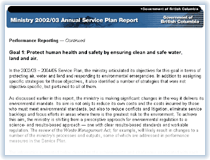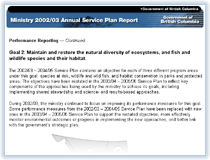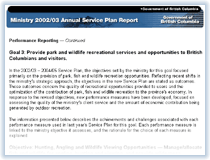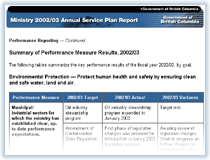 |
|
Performance ReportingThe Ministry of Water, Land and Air Protection is committed to excellence in performance reporting. Meeting that commitment requires clear articulation of the results desired from the ministry's programs, policies and services; selection of meaningful measures of success; and fair and credible reporting of performance relative to expected results. This section outlines the key successes of the ministry in delivering on the 2002/03 performance targets outlined in the 2002/03 – 2004/05 Service Plan.
In its 2002/03 – 2004/05 Service Plan, the ministry set out performance measures and initial targets in support of its focus on the following three core business areas and their associated goals and objectives:
Performance Reporting: A Process of Continuous ImprovementDuring the inaugural year of the Service Plan, many of the performance measures adopted were output measures, clear statements of the deliverables the ministry was committed to achieving through its regulatory reform projects (such as "overhaul of the Pesticide Control Act") or were related to operational processes (such as "timely distribution of annual freshwater sport fishing synopsis"). As the ministry's understanding and capacity for performance measurement improve, emphasis has been increasingly placed on a few critical output and outcome measures. These measures reflect the impact that the ministry intends its actions to have on client service and intermediate and long-term outcomes. This shift is apparent when one compares the 2002/03 – 2004/05 Service Plan with the 2003/04 – 2005/06 Service Plan. Effects of the Shift to Results-Based Performance MeasuresA major restructuring of the ministry was undertaken in January 2002 to better align the organization with the direction established by the Core Review process. That review process also prompted the ministry to adopt a results-based approach to measuring performance. Since January 2002, the ministry has spent considerable effort on refining its programs, policies and services. This period of transition has offered the ministry many opportunities for assessment and continuous improvement in aligning its goals, objectives and performance measures. The 2002/03 Annual Service Plan Report discloses the ministry's successes, challenges and changes in these areas. Assessing results rather than processes or projects requires using performance measures that focus on the effects that programs and services have on the environment and the ministry's public and other clients (outcomes) — not focusing on the effects of the processes and projects themselves (outputs). For this reason, many of last year's performance measures have been replaced in the current 2003/04 – 2005/06 Service Plan. Nevertheless, the processes are still considered to be important methods for achieving the ministry's objectives and have therefore become strategies in the new Service Plan; and the projects have become key deliverables in their respective core business area. The new performance measures (which will be reported on in next year's Annual Service Plan Report) are expected to better reflect desired environmental outcomes and to measure the quality of service provided to ministry clients. The Challenge of Developing Good Measures for Environmental Performance ReportingDeveloping good performance measures is a challenge shared by most environmental agencies. For example, it is difficult for the ministry to develop environment-related performance outcomes that will give an accurate indication of ministry performance and be those for which the organization can reasonably be held accountable. There are three main reasons for this challenge.
The rest of this section presents detailed information about the ministry's performance in attaining the targets it set in the 2002/03 – 2004/05 Service Plan for the 2002/03 fiscal year. The information is reported by each of last year's three core business areas and, under those, by goal and associated objectives. Included for each performance measure is the rationale for selecting the measure, the ministry's performance relative to the target identified in the Service Plan, and other key issues related to the measure. Where appropriate for some key measures, trend information is also presented (in graphs or tables) to provide readers with a greater understanding of the results over time. Given the limitations in the ministry's financial data, resource information by objective has not been presented. The ministry is working to address this issue. For details, see the "Report on Resources" section. For further information about the reliability and limitations of the data reported, see Appendix D — Performance Results: Data Completeness and Reliability. For definitions of distinct ministry terms or uncommon terms, see Appendix A — Glossary.
Core Business Area: Environmental ProtectionScopeThe core business area of Environmental Protection is led primarily by the Environmental Protection Division. Key programs and services in this business area relate to overseeing the environmental regulation of industries, promoting sustainable environmental practices in communities and monitoring industrial and community development to ensure compliance with established provincial environmental standards. These functions are aimed at protecting the health of British Columbians by improving the quality of air, land and water in the province. They also reflect the government's priority of ensuring a strong, private sector economy that maintains high environmental standards. Goal 1: Protect human health and safety by ensuring clean and safe water, land and air.
Core Business Area: Environmental StewardshipScopeThe core business area of Environmental Stewardship is led primarily by the Environmental Stewardship Division. Key programs and services in this business area focus on stewardship activities to maintain and restore the natural diversity of ecosystems, as well as fish and wildlife species and their habitats. To achieve this goal, this area is responsible for working with other ministries, industries, communities and governments to establish standards for governing the use and allocation of living resources. These functions reflect the government's priority of shared stewardship and sustainable economic development.
Goal 2: Maintain and restore the natural diversity of ecosystems, and fish and wildlife species and their habitat.
Core Business Area: Park and Wildlife RecreationScopeThe core business area of Park and Wildlife Recreation is also led primarily by the Environmental Stewardship Division. Key programs and services in this business area focus on applying a science-based approach to promote the effective management of fish, wildlife and park resources. To provide park and wildlife recreational services and opportunities to British Columbians, this business area establishes legislation, policies and procedures for park, fish and wildlife recreation. Working with First Nations, regional communities, other ministries and governments to protect recreational values and encourage recreation-linked economic activity is a key function of this business area. The following numbers show who is served by this core business area:
Goal 3: Provide park and wildlife recreational services and opportunities to British Columbians and visitors.
DeregulationAs part of its New Era commitments, the government pledged to reduce regulations by 33% overall. The ministry has a three-year plan to reduce regulations by 38%, ending June 30, 2004. As of March 31, 2003, the ministry reduced its regulations by 5,143, or 23.87%, from a baseline of 21,541 regulations. This is the initial step in reducing the economic burden of prescriptive regulations for industry and other stakeholders. The target for the 2003/04 fiscal year (by March 31, 2004) is a reduction of 2,257 regulations, or a further 11% of the total. Specific legislative reform work completed during fiscal 2002/03 for introduction to the Legislature in fiscal year 2003/04 (spring 2003 sitting) includes the Statutes Amendment Act, the Flood Hazards Statutes Amendment Act and the Integrated Pest Management Act. In addition, the Environmental Management Act, when passed, will replace the Environment Management Act and the Waste Management Act. Between April 1, 2004 and June 30, 2004, the ministry's regulations will be reduced by an additional 4%. Summary of Performance Measure Results, 2002/03
|
||||||||||||||||||||||||||||||||||||||||||||||
|
|||||||||||||||||||||||||||||||||||||||||||||||




